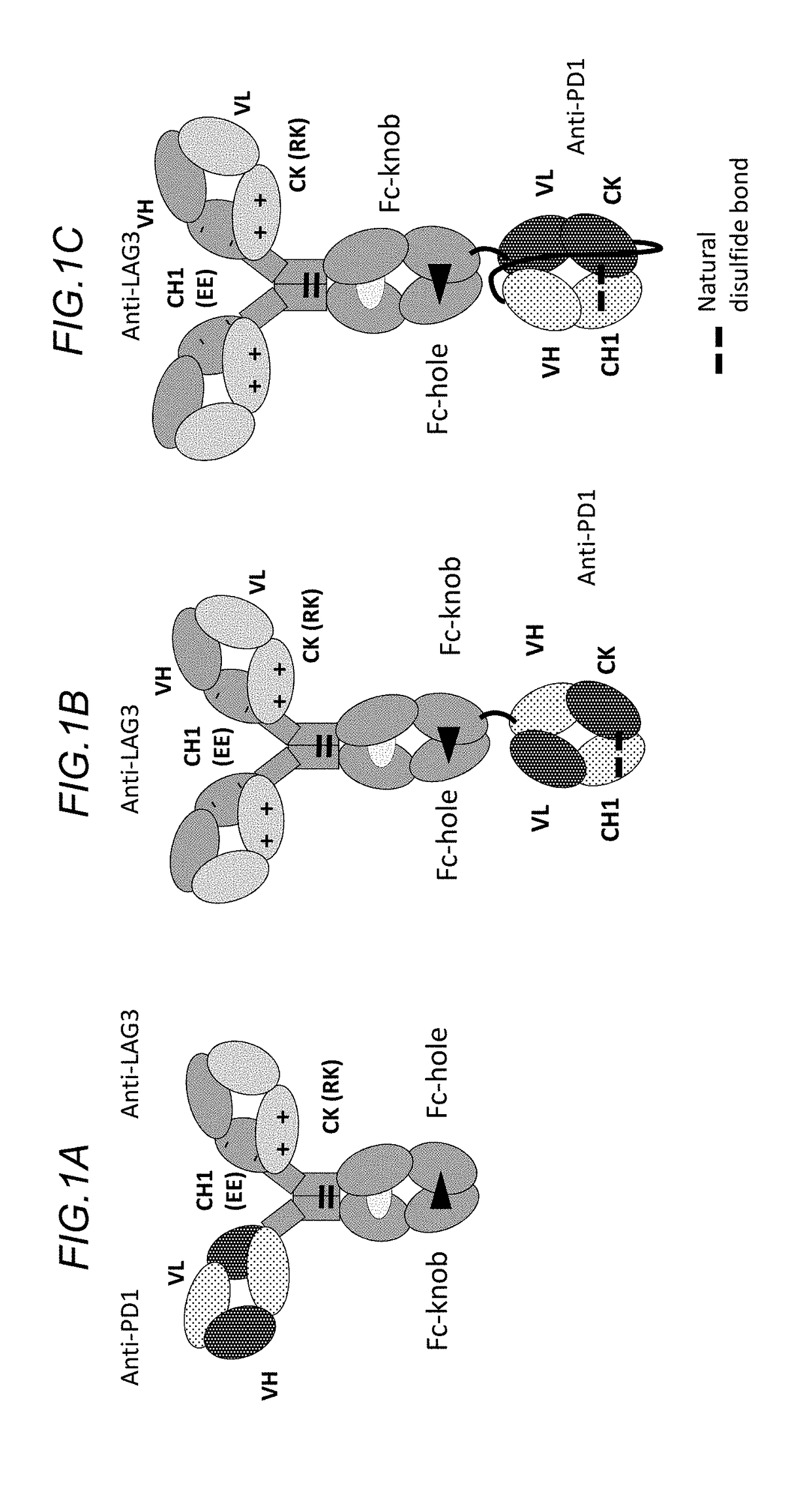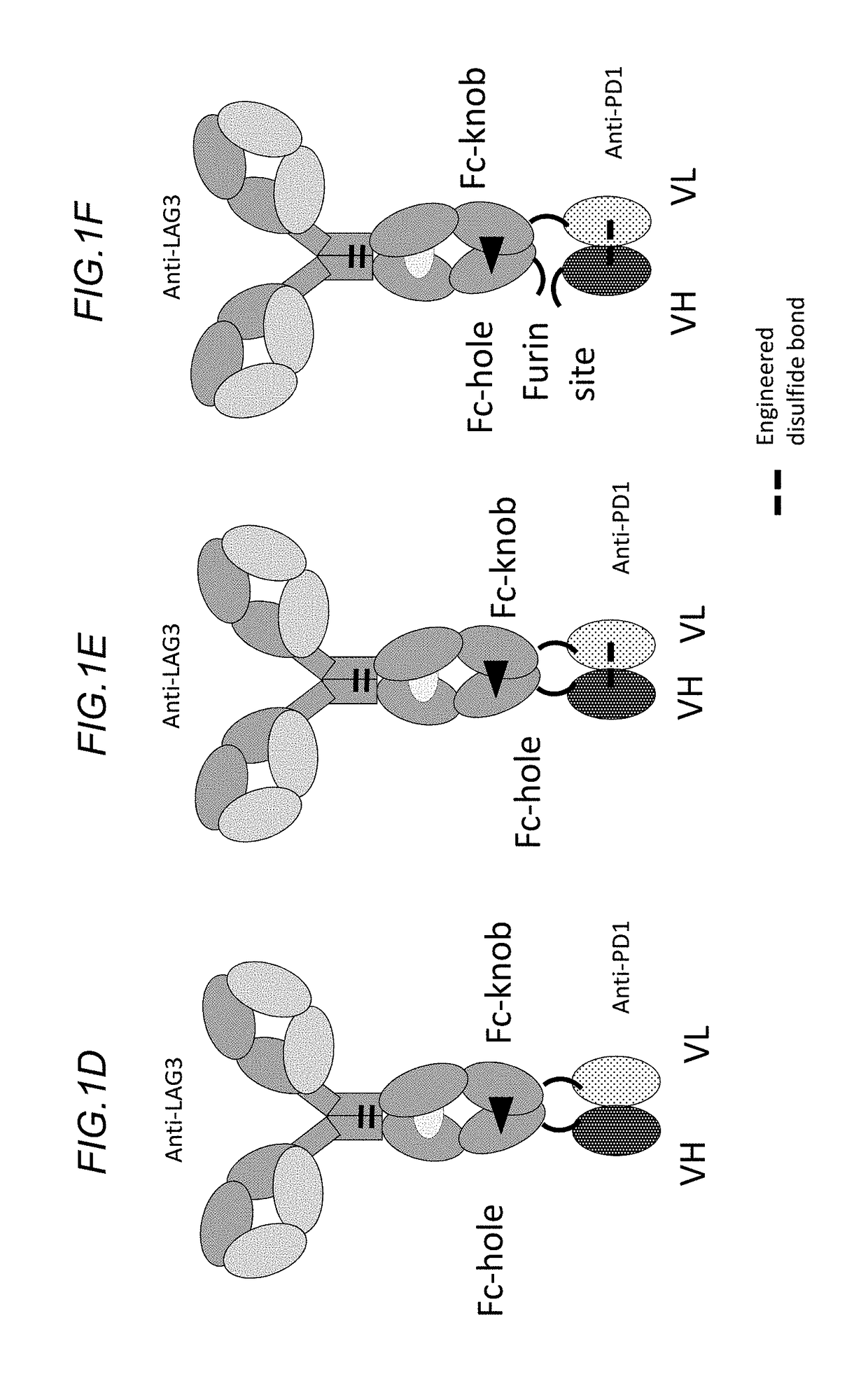Bispecific antibodies specifically binding to pd1 and lag3
a technology of specific antibodies and antibodies, applied in the field of specific antibodies, can solve the problems of increased infections and mortality, tumor evasion, persistence of viral infections, etc., and achieve the effects of reducing internalization, reducing sink effect, and improving selectivity
- Summary
- Abstract
- Description
- Claims
- Application Information
AI Technical Summary
Benefits of technology
Problems solved by technology
Method used
Image
Examples
example 1
Generation of Anti-PD-1 Antibodies
Immunization of Mice
[0834]NMRI mice were immunized genetically, using a plasmid expression vector coding for full-length human PD-1 by intradermal application of 100 ug vector DNA (plasmid15300_hPD1-fl), followed by Electroporation (2 square pulses of 1000 V / cm, duration 0.1 ms, interval 0.125 s; followed by 4 square pulses of 287.5 V / cm, duration 10 ms, interval 0.125 s. Mice received either 6 consecutive immunizations at days 0, 14, 28, 42, 56, 70, and 84. Blood was taken at days 36, 78 and 92 and serum prepared, which was used for titer determination by ELISA (see below). Animals with highest titers were selected for boosting at day 96, by intravenous injection of 50 ug of recombinant human PD1 human Fc chimera, and monoclonal antibodies were isolated by hybridoma technology, by fusion of splenocytes to myeloma cell line 3 days after boost.
Determination of Serum Titers (ELISA)
[0835]Human recombinant PD1 human Fc chimera was immobilized on a 96-we...
example 2
Characterization Anti-PD1 Antibodies / Binding of Anti-PD1 Antibodies to Human PD1
ELISA for hu PD1
[0836]Nunc maxisorp streptavidin coated plates (MicroCoat #11974998001) were coated with 25 μl / well biotinylated PD1-ECD-AviHis and incubated at 4° C. over night. After washing (3×90 μl / well with PBST-buffer) 25 μl anti PD1 samples or reference antibodies (human anti PD1; Roche / mouse anti PD1; Biolegend; cat.:329912) were added and incubated 1 h at RT. After washing (3×90 μl / well with PBST-buffer) 25 μl / well goat-anti-human H+L-POD (JIR, JIR109-036-088) / Sheep-anti-mouse-POD (GE Healthcare; NA9310) was added in 1:2000 / 1:1000 dilution and incubated at RT for 1 h on shaker. After washing (3×90 μl / well with PBST-buffer) 25 μl / well TMB substrate (Roche Catalogue No. 11835033001) was added and incubated until OD 2-3. Measurement took place at 370 / 492 nm.
ELISA results are listed as EC50-values [ng / ml] in Summary Tables 1 and 2 below.
Cell ELISA for PD1
[0837]Adherent CHO-K cell line stably transfe...
example 3
Effect of Different Anti-PD-1 Antibodies on Cytokine Production in a Mixed Lymphocyte Reaction (MLR)
[0857]3A) The Mixed Lymphocyte Reaction (MLR) is a immune cell assay which measures the activation of lymphocytes from one individual (donor X) to lymphocytes from another individual (donor Y). A mixed lymphocyte reaction was used to demonstrate the effect of blocking the PD1 pathway to lymphocyte effector cells. T cells in the assay were tested for activation and their IFNγ secretion in the presence or absence of an anti-PD1 mAbs.
[0858]To perform an allogeneic MLR, peripheral blood mononuclear cells (PBMCs) from at least four healthy donors of unknown HLA type were isolated by density gradient centrifugation using Leukosep (Greiner Bio One, 227 288). Briefly, heparinized blood samples were diluted with the three fold volume of PBS and 25 ml aliquots of the diluted blood were layered in 50 ml Leukosep tubes. After centrifugation at 800×g for 15 min at room temperature (w / o break) the ...
PUM
| Property | Measurement | Unit |
|---|---|---|
| dissociation constant | aaaaa | aaaaa |
| dissociation constant | aaaaa | aaaaa |
| dissociation constant | aaaaa | aaaaa |
Abstract
Description
Claims
Application Information
 Login to View More
Login to View More - R&D
- Intellectual Property
- Life Sciences
- Materials
- Tech Scout
- Unparalleled Data Quality
- Higher Quality Content
- 60% Fewer Hallucinations
Browse by: Latest US Patents, China's latest patents, Technical Efficacy Thesaurus, Application Domain, Technology Topic, Popular Technical Reports.
© 2025 PatSnap. All rights reserved.Legal|Privacy policy|Modern Slavery Act Transparency Statement|Sitemap|About US| Contact US: help@patsnap.com



